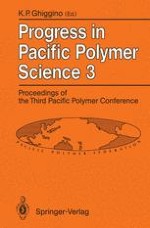1994 | OriginalPaper | Chapter
Novel Application of Natural Rubber Latex as Natural Flocculant for Tin Tailings Slurry
Authors : C. C. Ho, K. C. Lee, E. B. Yeap
Published in: Progress in Pacific Polymer Science 3
Publisher: Springer Berlin Heidelberg
Included in: Professional Book Archive
Activate our intelligent search to find suitable subject content or patents.
Select sections of text to find matching patents with Artificial Intelligence. powered by
Select sections of text to find additional relevant content using AI-assisted search. powered by
Natural rubber (NR) latex concentrate is essentially a stable dispersion of polyisoprene latex particles in an aqueous serum phase containing some minor constituents of soluble non-rubbers whereas tin tailings slurry is a very stable dispersion of mainly submicron size clay minerals with some heavier silt particles which normally settle out relatively fast. Under normal pH conditions, the negatively charged clay particles in the slurry would remain disperse for an extended period of time. There has not been much success in destabilizing this slurry with most of the common synthetic polymeric flocculants. It was found that when used in combination with an inorganic salt (e.g. calcium chloride) under optimum conditions, the negatively charged natural rubber latex particles can function as a polymeric flocculant in bringing about a complete heterocoagulation of the mixed dispersions whereby producing a clear supernatant and a porous sediment. The effect of pH, slime and latex concentrations on the heterocoagulation behaviour of the latex-slurry mixed dispersion was investigated. The influence of these factors on the efficiency of destabilization, the floe size of the sediment and the settling rate was compared with those which use calcium chloride only as coagulant. The floe size of the heterocoagulated latex-slurry mixtures decreased with increasing pH of the dispersion and slime concentration. The slurry could not be destabilised effectively using either latex or coagulant alone.
